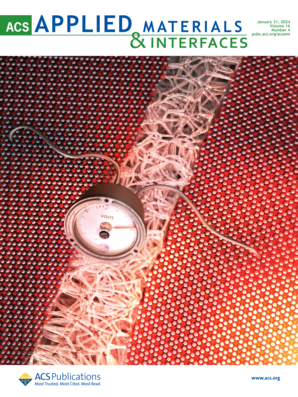Surface Fluorination of Silicone Rubber with Enhanced Stain Resistance and Slip Properties
IF 8.2
2区 材料科学
Q1 MATERIALS SCIENCE, MULTIDISCIPLINARY
引用次数: 0
Abstract
Silicone rubber (SR) holds significant potential for everyday wearable devices due to its inherent sweat resistance and flexibility. However, its broader applicability is constrained by poor oil resistance and a suboptimal slip performance. In this study, we developed an SR with durable oil resistance and enhanced slip properties by forming a covalently bonded barrier layer on its surface through a one-step in situ fluorination reaction using F2/N2. The fluorination process exploration revealed that low concentrations of F2 preferentially produce thermodynamic products containing Si–F bonds, while higher F2 concentrations favor the formation of C–F bonds and Si–F bonds with similar contents in the surface layer, as confirmed by theoretical simulations. This fluorine-containing surface modification significantly reduces the friction coefficient from 0.68 to 0.38 and imparts fascinating amphiphobic properties, increasing water and oil contact angles by 31.7 and 23.2°, respectively, compared to pristine SR. As a result, the fluorinated SR demonstrates superior slip performance and enhanced stain resistance, particularly against challenging contaminants like chili oil, even after frictional wear owing to the robustness of the covalently bonded surface layer. Additionally, the outstanding oil barrier properties of the fluorinated SR confer excellent antibacterial performance against Escherichia coli and Staphylococcus aureus, positioning it as a highly promising material for everyday wearable applications.

增强抗污和防滑性能的硅橡胶表面氟化
硅橡胶(SR)由于其固有的抗汗性和灵活性,在日常可穿戴设备中具有巨大的潜力。然而,其更广泛的适用性受到较差的耐油性和次优滑移性能的限制。在这项研究中,我们通过F2/N2一步原位氟化反应在其表面形成共价键阻挡层,从而开发出具有持久耐油和增强滑动性能的SR。氟化过程探索发现,低浓度的F2优先生成含有Si-F键的热力学产物,而高浓度的F2有利于在表层形成含量相近的C-F键和Si-F键,理论模拟证实了这一点。这种含氟表面改性显著降低了摩擦系数,从0.68降至0.38,并赋予了迷人的双疏性,与原始SR相比,水和油的接触角分别增加了31.7°和23.2°。因此,氟化SR具有优越的防滑性能和增强的抗污性,特别是对辣椒油等具有挑战的污染物。即使经过摩擦磨损,由于共价键合表面层的坚固性。此外,氟化SR出色的隔油性能赋予了对大肠杆菌和金黄色葡萄球菌的出色抗菌性能,使其成为日常可穿戴应用的极具前景的材料。
本文章由计算机程序翻译,如有差异,请以英文原文为准。
求助全文
约1分钟内获得全文
求助全文
来源期刊

ACS Applied Materials & Interfaces
工程技术-材料科学:综合
CiteScore
16.00
自引率
6.30%
发文量
4978
审稿时长
1.8 months
期刊介绍:
ACS Applied Materials & Interfaces is a leading interdisciplinary journal that brings together chemists, engineers, physicists, and biologists to explore the development and utilization of newly-discovered materials and interfacial processes for specific applications. Our journal has experienced remarkable growth since its establishment in 2009, both in terms of the number of articles published and the impact of the research showcased. We are proud to foster a truly global community, with the majority of published articles originating from outside the United States, reflecting the rapid growth of applied research worldwide.
 求助内容:
求助内容: 应助结果提醒方式:
应助结果提醒方式:


